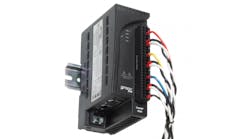The benefits of baking predictive-maintenance functions into production assets
By Garron Morris, Sr., Rockwell Automation principal engineer
Many forward-thinking industrial producers already use predictive maintenance to identify equipment problems early and get ahead of downtime events. And now, technology advances like self-aware variable-frequency drives are making this smarter approach to maintenance easier to implement.
Rockwell Automation's Garron Morris, Sr.
Self-aware drives contain within their firmware all the analytics technology you need to implement predictive maintenance. They use advanced physics-of-failure models to convert stressors, such as speed, voltage and temperature, into component-life consumption. This allows them to calculate how many hours remain until the percentage of consumed life reaches its event level, which is the maximum life consumed before an alarm is generated.
When a component reaches an event level as defined by the user, the drive informs maintenance personnel that preventive maintenance is needed.
Predictive models are tailored to the drive components that they monitor. This can help you more confidently use and replace components such as:
Power semiconductors: The predictive models for drive-power semiconductors known as IGBTs are based on a physics-of-failure model created from IGBT-manufacturer data and extensive testing. The models address two IGBT failure modes: short-term bond-wire fatigue and long-term solder fatigue.
As you’d probably expect, applications with high internal IGBT temperature cycles will consume life faster than applications with low temperature cycles. To calculate these temperature cycles, a combination of internal sensors, control parameters and advanced thermal models are used.
Because the predictive models rely on real drive operation, they consider the dynamic nature of the drive operation to capture actual life consumption. Elapsed- and remaining-life calculations are updated every minute, and the remaining-life calculation is determined based on the user-defined event level.
Fans: Predictive models for each fan are based on physics-of-failure models for bearing life and any life-limiting electronics that either have reliability data from the fan manufacturer or have undergone life testing.Fan life is affected by local air temperature, fan speed and total rotation time. To track local air temperature, the predictive model either uses direct measurements or accurate estimations from one or more air-temperature sensors. For the rotational time, the drive tracks a fan’s on/off state and the actual fan speed is monitored. When a fan is not rotating, life isn’t being consumed.A fan-derating parameter also reduces the calculated remaining life. This parameter accounts for other stresses, like environmental contamination, that reduce fan life.
DC bus capacitors: A DC bus capacitor’s predictive model is based on a physics-of-failure model from the manufacturer. Two factors that affect capacitor life are internal temperature and applied voltage. To calculate the heat generated inside the capacitors, the predictive model uses several sensor and control values. The internal temperature is calculated from two temperature sensors and the heat-generation estimates using an empirical model derived from extensive thermal testing.
Contactors and switches: The lifespan models for a drive’s main circuit breaker, precharge contactor and molded case switch are all based on the number of no-load disconnect actions. Each action consumes life from the total available life of these components.
Line capacitors: The line-capacitor life in a drive’s LCL filter is most affected by capacitor temperature. The predictive model combines manufacturer data with a physics-of-failure model that uses temperature as an input.Capacitor temperature is calculated from a model that uses data from extensive thermal testing. The component’s life is consumed faster as the ambient temperature increases, and elapsed and remaining life calculations are updated by the minute.
So what does this all mean? Savings!
Predictive maintenance has proven to be a winning strategy for reducing unplanned downtime and boosting overall productivity. And when you use drives with built-in predictive-maintenance functions, a lot of the hard work is done for you.
The drives already have life models that learn and adapt to changes in the application and environment, so you just need to develop a maintenance plan for using the insights the drives give you via life consumed and predicted remaining lifetime.



